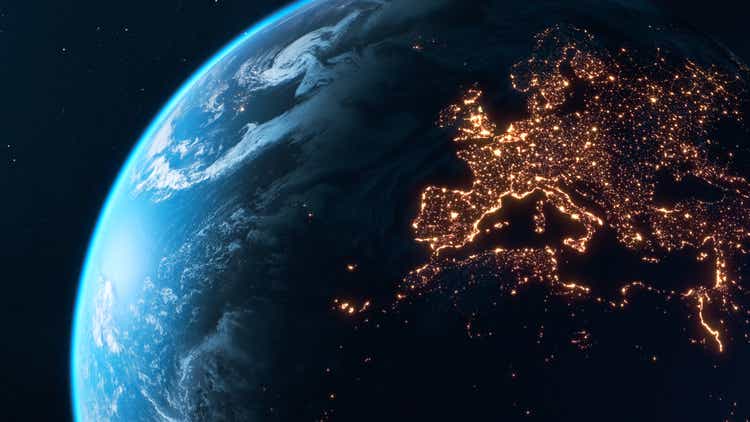Planet Earth At Night – City Lights of Europe Glowing In The Dark DKosig/iStock via Getty Images
After attending an event in which a leading Russian expert presented about Russia and the Ukraine crisis, I will relay my thoughts regarding how this crisis intersects with energy trends. I had promised this to readers. A select few ideas follow but Chatham House rules apply:
One of the most resounding messages from this non-U.S.-centric perspective was that Putin’s Russia has been planning for Russia’s comeback since the early 2000s. The West has been tone-deaf to the intentions and signs along the way. This idea has been circulating among geopolitical analysts of late as well.
Inherent in the positioning of Russia has been Putin’s grand strategy, which is difficult to implement. While many commentators focus on Russia’s past empire-focused aspirations and Cold War framing, the strategy is more forward-looking. Its contours reflect a different geopolitical reality that also considers Asia’s economic rise as much as anything. Russia wants to be considered important in this shifting 21st Century paradigm. Another pressure point for Russia has been the rise of U.S. hydrocarbon production, impacting its budget and adding another geoeconomic factor. The Western allies via NATO have enlarged over time and Russia has reacted at the inflection points. This is some of the gist which causes me to tread carefully in my assumptions.
I’m free associating here next. First, there are many reasons Saudi Arabia hasn’t been as warm to the U.S. as in years past owing to – wavering support, their Asia-facing markets, uncertainty regarding energy transition policies, and domestic economic diversification. Think geopolitics and geo-economics. Russia is the other counterbalance in OPEC-plus, though there have been times when Putin made the wrong call, example being during the pandemic. (I referred to this in an April 2020 article“… OPEC+ Agree to Cut 10 Million In Next Months.”) This expanded pact works well for OPEC, Russia and the cartel’s role in setting the hydrocarbon agenda as a counterbalance to the U.S., Australia and other free market players.
In The Economist article of March 26, they note that Saudi Aramco (ARMCO) is upping investment to around $40 – 50 billion this year from $32 billion in 2021.
Add to that:
“Saudi Aramco (ARMCO), which produces 12.8m barrels of oil equivalent per day, has just attained a market value of more than $2.3trn, making it the world’s second-most-valuable listed company after Apple (AAPL).”
The two most valuable companies now are Saudi Aramco and Apple: A first exporter of hydrocarbons in 1939 and a foremost technology innovator founded in 1976, respectively. Thirty-seven years separate their value creation.
But the world has changed, again. Innovation in energy has been happening for decades, not just with the advent of ESG and climate change. This rests with entrepreneurs, scientists, governments and other types of people willing to place bets. Putin has placed his. And now the geopolitics and geoeconomics are shifting in different ways. Europe is hastening its diversification of energy sources. U.S. natural gas exports will play a larger role now than expected. What might have been considered a marginal project a few years back is more likely to happen, such as Tellurian’s (TELL) Driftwood LNG facility.
In spite of the damage to Russia’s role in the world, its large hydrocarbon assets are important and have value. According to Nikos Tsafos from a think tank in D.C.:
“Russia is central to the global energy system. It is the world’s largest exporter of oil, making up about 8% of the global market. And it supplies Europe with 45% of its natural gas, 45% of its coal and 25% of its oil. Likewise, hydrocarbons are the lifeline of Russia’s economy. In 2019, before COVID-19 depressed prices, revenues from oil and natural gas accounted for 40% of the country’s federal budget. And oil and gas accounted for almost half of Russia’s total goods exports in 2021.”
My theme is therefore about reversals and a propensity toward consensus-thinking that clouds clarity about what is happening. Admittedly, it’s a tough call and an even harder perspective to maintain when global peace and right actions are at stake. Below are some basic observations at play in the present.
1) Europe’s diversification of its energy mix will be favorable to U.S. oil and gas production. More new deals are being made. But OPEC-plus isn’t going anywhere for now.
2) However, the energy transition is also at play. The interaction of these two forces is fuzzy. I do not have a clear line of sight regardless of the capital flows at present with many moving parts and mixed messaging in terms of policy, geopolitics and energy security realities. Everyone is talking their book.
My book is the intersection of real economics (like real politik), the practical side, with a thesis about sustainability and doing good with capital. The world is so interconnected that disentangling the many funds’ constituent’s country exposure would be time-consuming and unconstructive. This period of time is marked by uncertainty, but conviction can and does play a constructive role.
A diversified energy portfolio in both oil and gas, with a mix of U.S.-based production and progressive majors, and low-carbon energy and sustainable resource-oriented infrastructure is my optimal mix. This has been my mantra for many years now. In my portfolio, a slight increase in holdings – such as U.S. natural gas-weighted producer Range Resources (RRC), added on February 24th, and a select energy ETF (PXE) with top U.S. oil producers in November – made sense given trend lines.
As a bystander that pays attention to geopolitics and energy, I’m humbled by developments. It’s sobering. Nevertheless, investors have to invest, players gotta play.


Be the first to comment